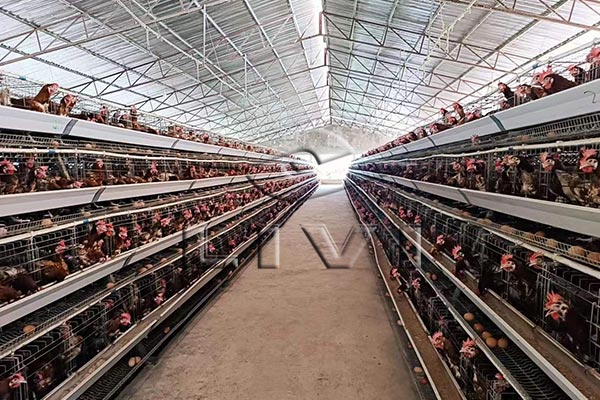In the competitive world of modern poultry farming, efficiency, automation, and high yield are the keys to success. One of the most effective systems that has transformed layer poultry farming is the 50000 layers battery cage system, specifically the A Type battery cage system. This article explores how a high-capacity battery chicken cage system housing over 50,000 egg-laying hens can significantly improve productivity, reduce labor, and enhance farm profitability.

What is a Battery Chicken Cage System?
A battery cage system refers to an arrangement of cages in rows and tiers, designed to house egg-laying hens in a highly organized and efficient structure. This system is widely used around the world due to its compact design, labor-saving automation, and ability to house a large number of birds in a relatively small space.
Among various designs, the A Type layer battery cage system is one of the most popular and trusted models, especially for medium to large-scale poultry farms.
Key Features of the 50,000 Layers Battery Chicken Cage System
To understand how such a large-scale system operates, let’s take a closer look at the configuration of a 50,000-layers battery cage poultry house setup:
-
Poultry House Dimensions: Each house measures 100 meters in length, 15 meters in width, and 4 meters in height.
-
Cage Configuration:
-
A Type Battery Cage Design
-
4 tiers, 4 rows per house
-
42 cage sets per row
-
Each cage set holds 160 birds
-
-
Total Bird Capacity:
-
One house holds 26,880 egg-laying hens
-
With two identical houses: 53,760 laying hens
-
This configuration maximizes space utilization while ensuring comfort, hygiene, and egg-laying efficiency for each hen.
Space Optimization and High Bird Density
Each A Type layer battery cage is meticulously engineered to provide:
-
Ample feeding and drinking space
-
Adequate ventilation and light exposure
-
Easy egg collection and manure removal
By placing 42 cage sets per row in 4 rows, and using a 4-tier vertical stacking, this system can host 26,880 layers in one poultry house, covering only 1000–1500 square meters. This results in:
-
Over 26 birds per square meter, without sacrificing hen welfare
-
Efficient use of land, perfect for regions with limited space or high land costs
Fully Automated Poultry Management System
The 50,000-layer setup is equipped with a fully automated management system that significantly reduces labor costs and human error. Here are the main automated features:
1. Automatic Feeding System
Feed is stored in a central silo, then automatically distributed via feed uploading systems to each cage row. This ensures consistent and timely feeding, improving feed conversion rates.
2. Automatic Egg Collecting Machine
Eggs roll gently onto a collection belt and are transferred to a central egg collection point, minimizing egg breakage and contamination.
3. Manure Removal System
Options include:
-
PP Belt Manure Removal: Continuous cleaning using durable polypropylene belts.
-
Scraper Waste Removal System: Mechanical scrapers that push manure to designated disposal points.
This keeps the poultry house hygienic and reduces ammonia levels, improving bird health and egg quality.
4. Automatic Drinking System
Each cage has a nipple drinking system, ensuring birds have access to clean, fresh water at all times with minimal waste.

Economic Advantages of the 50,000 Layers Cage System
Investing in an automated battery cage system for 50,000 layers may seem capital-intensive at first, but the long-term economic benefits are significant.
1. Increased Egg Production
-
With controlled feeding, lighting, and climate, hens reach optimum laying performance.
-
Expected average egg production rate: 92%–95%, equating to ~49,000–51,000 eggs daily from the system.
2. Labor Savings
-
One technician can manage an entire automated house, reducing the need for manual workers.
-
Lower labor costs, especially in countries with rising wage demands.
3. Improved Feed Efficiency
-
Automatic feeding reduces waste and overfeeding.
-
Birds are healthier, requiring fewer medications or treatments.
4. Manure Utilization
-
Collected manure can be recycled as organic fertilizer or sold, generating additional revenue streams.
Environmental and Health Considerations
Modern poultry farms are under increasing pressure to reduce their environmental footprint. The A Type battery cage system addresses these concerns:
-
Hygiene and Disease Control: Regular manure removal and enclosed housing reduce disease spread.
-
Air Quality: Better ventilation and ammonia control help maintain optimal air quality inside the house.
-
Water Conservation: Nipple drinkers use significantly less water than open troughs.

Is This System Right for You?
If you are a poultry farm owner or investor planning to scale operations or start a commercial egg production facility, this setup is ideal if:
-
You have medium to large land availability (minimum ~3000m² for 2 houses)
-
You aim to produce at least 50,000 eggs daily
-
You want to minimize labor and maximize ROI with automation
With the right design, installation, and management, a 50,000-layer A Type battery cage system can turn into a highly productive and profitable long-term investment.
Conclusion
A 50,000-layer battery chicken cage system is the pinnacle of efficiency in commercial poultry farming. With a fully automated setup, optimized space utilization, and the capacity to produce over 50,000 eggs per day, this system represents the future of poultry operations.
Whether you’re upgrading an existing farm or building a new layer operation from scratch, adopting this A Type battery cage system could drastically improve your farm’s productivity, animal welfare, and profit margins.
For tailored advice, system design, and installation, reach out to a professional poultry equipment supplier who can help bring your poultry vision to life.
